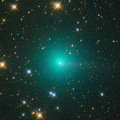
|
Now it is so bright as 6.8 mag (June 12, Marco Goiato). It will be fading gradually after this. In the Northern Hemisphere, it is observable until mid August in the evening low sky. In the Southern Hemisphere, it will be getting lower after this, and will be too low to observe in late August.
Date(TT) R.A. (2000) Decl. Delta r Elong. m1 Best Time(A, h)
June 20 12 57.19 -29 13.6 1.124 1.799 114 7.2 21:04 ( 28, 20)
June 27 12 45.75 -21 21.1 1.271 1.799 103 7.5 21:04 ( 41, 22)
|
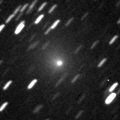
|
Now it is so bright as 8.6 mag (June 18, Marco Goiato). It will never be observable again in the Northern Hemisphere. In the Southern Hemisphere, it keeps observable for a long time after this in the evening sky.
Date(TT) R.A. (2000) Decl. Delta r Elong. m1 Best Time(A, h)
June 20 7 58.98 -2 13.8 1.798 1.207 39 8.3 21:04 ( 96,-14)
June 27 8 15.20 -6 37.8 1.800 1.221 40 8.4 21:04 ( 94,-18)
|
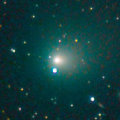
|
Now it is so bright as 8.8 mag (June 17, Juan Jose Gonzalez). It will be observable at 8-10 mag in good condition for a long time until late autumn.
Date(TT) R.A. (2000) Decl. Delta r Elong. m1 Best Time(A, h)
June 20 22 23.17 35 30.9 2.902 3.130 93 8.5 2:59 (262, 71)
June 27 22 12.69 35 12.9 2.784 3.128 100 8.4 3:01 (265, 79)
|
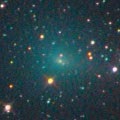
|
Now it is very bright as 9.3 mag (June 19, Marco Goiato). It will be bright at 9-10 mag for a long time until autumn.
Date(TT) R.A. (2000) Decl. Delta r Elong. m1 Best Time(A, h)
June 20 22 27.05 -9 28.2 0.892 1.599 113 9.3 2:59 (328, 40)
June 27 22 37.21 -9 9.5 0.862 1.611 117 9.3 3:01 (334, 42)
|
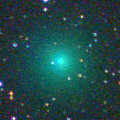
|
It was bright as 8-9 mag in April and May. Now it is not observable. But it will appear in the morning sky again at 12 mag in late August, then it will be fading slowly in the low sky. In the Southern Hemisphere, it keeps observable in good condition for a long time after August.
Date(TT) R.A. (2000) Decl. Delta r Elong. m1 Best Time(A, h)
June 20 6 18.33 29 59.4 2.430 1.433 8 10.0 21:04 (137,-10)
June 27 6 31.60 26 51.9 2.495 1.483 3 10.2 21:04 (138,-14)
|
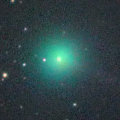
|
It has been observed bright as 8-9 mag from April to June. It is bright as 9.3 mag still now (June 13, Marco Goiato). However, it will be fading after this. In the Southern Hemisphere, it keeps observable in a good condition for a long time. In the Northern Hemisphere, it will never be observable again.
Date(TT) R.A. (2000) Decl. Delta r Elong. m1 Best Time(A, h)
June 20 5 14.57 -61 50.6 1.205 1.517 85 10.2 2:59 (326,-47)
June 27 6 25.61 -61 13.9 1.320 1.588 84 10.6 21:04 ( 33,-51)
|
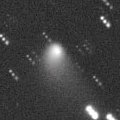
|
Now it is very bright as 9.8 mag (June 13, Marco Goiato). It keeps as bright as 10-11 mag for a long time untio 2010 spring. It is not observable in the Northern Hemisphere now. But it will appear in the morning sky in early October, then it keeps observable at 10 mag in good condition for a long time. In the Southern Hemisphere, it will be unobservable soon.
Date(TT) R.A. (2000) Decl. Delta r Elong. m1 Best Time(A, h)
June 20 7 37.75 -5 33.2 3.287 2.570 38 11.0 21:04 ( 97,-20)
June 27 7 50.07 -4 12.7 3.302 2.533 34 10.9 21:04 (101,-22)
|
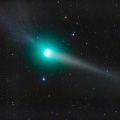
|
It passed near by the earth in late February, and it reached up to 4.9 mag (Feb. 23, Juan Jose Gonzalez). It has faded down to 11.8 mag (May 17, Carlos Labordena), and became unobservable. But it will appear in the morning sky again at 14 mag in August.
Date(TT) R.A. (2000) Decl. Delta r Elong. m1 Best Time(A, h)
June 20 6 55.03 21 55.4 3.553 2.579 14 12.8 21:04 (126,-10)
June 27 6 58.46 21 49.5 3.659 2.657 8 13.0 21:04 (130,-14)
|

|
Now it is very bright as 11.1 mag (June 14, Marco Goiato). It will be too low to observe in the evening sky in July.
Date(TT) R.A. (2000) Decl. Delta r Elong. m1 Best Time(A, h)
June 20 10 41.58 9 20.3 2.318 2.185 69 12.9 21:04 ( 83, 26)
June 27 10 53.04 8 0.0 2.383 2.181 66 12.9 21:04 ( 84, 22)
|
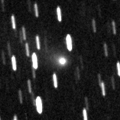
|
New bright periodic comet. Now it is 12.9 mag and visible visually (June 17, Juan Jose Gonzalez). Moving northwards in the Milky Way. In the Northern Hemisphere, the condition becomes good after this. But the comet will fade out rapidly. It will be fainter than 15 mag in August, and fainter than 18 mag in October.
Date(TT) R.A. (2000) Decl. Delta r Elong. m1 Best Time(A, h)
June 20 18 18.42 -10 43.5 0.334 1.342 166 12.9 0:26 ( 0, 44)
June 27 18 21.02 -5 43.7 0.362 1.366 162 13.1 0:01 ( 0, 49)
|
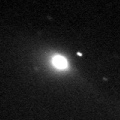
|
It brightened very rapidly, faster than expected, and reached up to 9.3 mag in spring (Mar. 26, Juan Jose Gonzalez). Now it is fading. However, it is still very bright as 9.7 mag (May 26, Juan Jose Gonzalez). But it will be unobservable soon.
Date(TT) R.A. (2000) Decl. Delta r Elong. m1 Best Time(A, h)
June 20 8 22.51 24 30.3 2.550 1.797 33 13.1 21:04 (115, 7)
June 27 8 41.77 23 21.6 2.636 1.850 31 13.4 21:04 (115, 5)
|

|
The condition of this return is bad, and it has not been observed yet. Now appearing in the morning sky. It will be getting higher gradually while fading slowly after this.
Date(TT) R.A. (2000) Decl. Delta r Elong. m1 Best Time(A, h)
June 20 3 52.85 25 51.7 2.196 1.379 27 13.3 2:59 (240, 3)
June 27 4 18.97 26 54.1 2.194 1.386 28 13.3 3:01 (240, 5)
|

|
It reaches up to 11 mag in 2009 summer. However, the condition of this apparition is worst. We can not observe it at all.
Date(TT) R.A. (2000) Decl. Delta r Elong. m1 Best Time(A, h)
June 20 6 4.65 24 59.1 2.392 1.378 2 14.2 21:04 (137,-15)
June 27 6 30.59 25 23.0 2.353 1.339 2 13.6 21:04 (137,-15)
|
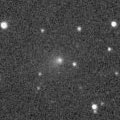
|
It is already bright as 13.2 mag and visible visually (June 17, Juan Jose Gonzalez). It will be brightening rapidly after this, and will be 10 mag in autumn. It keeps observable for a long time until 2010 February. But in the Northern Hemisphere, it will be lower than 20 degree after August, then it keeps very low all through the brightest time. It locates a bit higher in the Southern Hemisphere.
Date(TT) R.A. (2000) Decl. Delta r Elong. m1 Best Time(A, h)
June 20 12 28.44 -1 18.6 1.365 1.816 98 13.9 21:04 ( 52, 39)
June 27 12 34.53 -2 21.6 1.391 1.772 93 13.7 21:04 ( 56, 35)
|

|
It brightened up to 9.8 mag in December and January (Dec. 28, Juan Jose Gonzalez). Now it is fading, but still bright as 12.5 mag (May 26, Juan Jose Gonzalez). It will be unobservable soon. However, it will be observable in good condition again in winter at 15 mag. Then it may be still visible visually.
Date(TT) R.A. (2000) Decl. Delta r Elong. m1 Best Time(A, h)
June 20 8 17.01 24 13.8 4.615 3.798 32 13.7 21:04 (116, 6)
June 27 8 25.40 23 18.3 4.719 3.851 27 13.8 21:04 (118, 2)
|
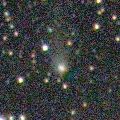
|
It brightened up to 11.5 mag in last summer (Aug. 4, Marco Goiato). Although it is not observable in the Northern Hemisphere, it keeps observable in good condition for a long time in the Southern Hemisphere. However, no visual observations have been reported since last summer. Recent CCD observations suggest that it is still visible visually around 12-13 mag.
Date(TT) R.A. (2000) Decl. Delta r Elong. m1 Best Time(A, h)
June 20 5 39.84 -39 50.3 3.791 3.457 63 13.8 2:59 (292,-52)
June 27 5 48.13 -38 59.7 3.847 3.502 62 13.9 3:01 (292,-48)
|
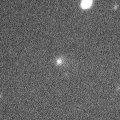
|
It has already brightened up to 14.3 mag (June 12, Artyom Novichonok). It will brighten rapidly after this, and will be observable at 10-11 mag in a good condition for a long time from summer to winter.
Date(TT) R.A. (2000) Decl. Delta r Elong. m1 Best Time(A, h)
June 20 23 15.48 -5 52.9 1.035 1.585 101 14.2 2:59 (313, 37)
June 27 23 37.53 -5 11.1 0.949 1.534 102 13.8 3:01 (315, 39)
|

|
Now it is not observable. It will appear in the morning sky in September.
Date(TT) R.A. (2000) Decl. Delta r Elong. m1 Best Time(A, h)
June 20 8 17.93 20 28.2 6.962 6.139 33 14.1 21:04 (112, 4)
June 27 8 22.93 20 7.3 7.021 6.141 27 14.1 21:04 (115, -1)
|

|
Now it is 12.7 mag and visible visually (June 1, Juan Jose Gonzalez). It will brighten up to 12-13 mag in 2010 summer. In 2009, it keeps observable in good condition until summer.
Date(TT) R.A. (2000) Decl. Delta r Elong. m1 Best Time(A, h)
June 20 12 2.45 9 0.9 2.715 2.870 88 14.5 21:04 ( 68, 42)
June 27 12 7.27 7 59.5 2.786 2.850 83 14.5 21:04 ( 71, 37)
|
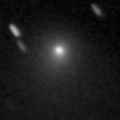
|
It reached to 10.9 mag in May (May 11, Marco Goiato). It is fading slowly. Now it is 13.4 mag (June 1, Juan Jose Gonzalez), still visible visually. It keeps bright as 13-14 mag for a long time after this until summer.
Date(TT) R.A. (2000) Decl. Delta r Elong. m1 Best Time(A, h)
June 20 16 11.74 37 35.4 3.904 4.422 114 14.7 22:16 (180, 87)
June 27 16 8.55 37 24.3 3.998 4.472 111 14.8 21:45 (180, 88)
|
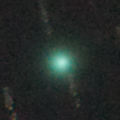
|
It brightened rapidly, and it reached up to 7.5 mag on Apr. 5 (Juan Jose Gonzalez). It is fading now. But it is still very bright as 10.3 mag (June 1, Juan Jose Gonzalez). It will be getting higher gradually after this, and it keeps observable until it has gone away. It will be visible visually for some more time.
Date(TT) R.A. (2000) Decl. Delta r Elong. m1 Best Time(A, h)
June 20 22 20.25 26 55.6 1.009 1.533 98 14.8 2:59 (286, 69)
June 27 21 41.80 23 45.7 0.952 1.638 112 15.3 3:01 (335, 78)
|
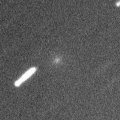
|
Now it is bright as 14.0 mag and visible visually (June 11, Juan Jose Gonzalez). However, it will be getting lower very rapidly in the evening sky, and will be too low to observe in early August. It was discovered in May, but it must have been bright and observable in the northern sky since winter.
Date(TT) R.A. (2000) Decl. Delta r Elong. m1 Best Time(A, h)
June 20 9 28.62 36 1.0 2.052 1.559 47 15.0 21:04 (117, 25)
June 27 9 51.87 32 27.5 2.077 1.563 46 15.0 21:04 (114, 23)
|
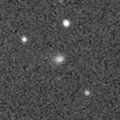
|
It has brightened up to 14 mag in outburst in 2008 August. It has not been observable for a long time, but it is appearing in the morning sky. Now it is bright as 15.4 mag (May 8, Ken-ichi Kadota), brighter than originally expected.
Date(TT) R.A. (2000) Decl. Delta r Elong. m1 Best Time(A, h)
June 20 21 26.65 -31 51.1 2.195 2.979 132 15.1 2:59 (352, 23)
June 27 21 27.19 -33 9.3 2.148 2.988 138 15.0 3:01 (359, 22)
|
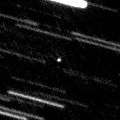
|
It passes the perihelion in June, and brightens up to 13.5 mag. But it is not observable, too close to the sun.
Date(TT) R.A. (2000) Decl. Delta r Elong. m1 Best Time(A, h)
June 20 6 20.54 21 0.2 0.930 0.141 6 15.1 21:04 (132,-16)
June 27 5 20.96 29 33.5 0.856 0.296 15 15.8 3:01 (229, -5)
|

|
Now it is 13.7 mag (June 1, Juan Jose Gonzalez). It had been bright and visible visually around 13 mag from spring to autumn in 2008. It will be visible visually at 14 mag again until summer.
Date(TT) R.A. (2000) Decl. Delta r Elong. m1 Best Time(A, h)
June 20 13 16.85 36 59.6 6.622 6.719 91 15.2 21:04 (103, 69)
June 27 13 13.10 36 32.2 6.747 6.746 85 15.3 21:04 (103, 63)
|
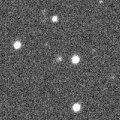
|
Now it is 16.1 mag (May 25, Ken-ichi Kadota). It will brighten up to 15 mag in 2009 and 2010, and will be observable for a long time in good condition.
Date(TT) R.A. (2000) Decl. Delta r Elong. m1 Best Time(A, h)
June 20 20 18.65 56 15.9 2.698 2.959 94 15.4 2:27 (180, 69)
June 27 19 48.76 58 16.6 2.642 2.936 96 15.3 1:30 (180, 67)
|
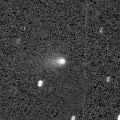
|
Now it is visible visually at 13.6 mag (Apr. 23, Mitsunori Tsumura). It will keep 14-15 mag for a while. But it will be getting lower rapidly after this, and will be too low to observe in July.
Date(TT) R.A. (2000) Decl. Delta r Elong. m1 Best Time(A, h)
June 20 11 47.25 -4 2.1 2.078 2.313 90 15.4 21:04 ( 59, 30)
June 27 11 53.70 -5 36.8 2.158 2.311 85 15.4 21:04 ( 62, 25)
|
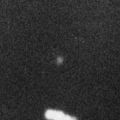
|
Now it is 15.2 mag (June 11, Artyom Novichonok). It keeps observable in good condition at 15 mag until late autumn.
Date(TT) R.A. (2000) Decl. Delta r Elong. m1 Best Time(A, h)
June 20 0 46.40 10 31.7 4.063 3.907 73 15.5 2:59 (280, 31)
June 27 0 47.97 12 3.6 3.954 3.903 79 15.4 3:01 (283, 38)
|
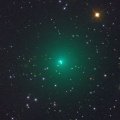
|
It brightened much faster than expected, and reached up to 8.4 mag (Jan. 30, Juan Jose Gonzalez). It was very large and visible through binoculars. Now it is fading rapidly. But it is still bright as 15.2 mag (June 12, Artyom Novichonok). It will be too low to observe in July.
Date(TT) R.A. (2000) Decl. Delta r Elong. m1 Best Time(A, h)
June 20 10 22.14 6 32.2 2.294 2.103 66 15.7 21:04 ( 83, 21)
June 27 10 35.99 5 20.4 2.408 2.151 63 16.0 21:04 ( 84, 17)
|
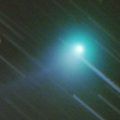
|
It reached to 6.3 mag in 2008 September in the southern sky (Sept. 4, Marco Goiato). Now it is fading. It has already faded down to 16.2 mag (May 8, Ken-ichi Kadota). It keeps observable in the northern sky while fading gradually. In the Southern Hemisphere, it will never be observable again.
Date(TT) R.A. (2000) Decl. Delta r Elong. m1 Best Time(A, h)
June 20 2 59.03 82 46.0 4.123 3.745 61 15.7 2:59 (189, 34)
June 27 3 51.39 83 35.3 4.195 3.819 61 15.8 3:01 (188, 34)
|

|
Now it is 16.7 mag (May 19, Ken-ichi Kadota), brightening as expected. It will reach up to 12 mag in 2012, and will be observable visually at 12-13 mag for a long time from 2011 to 2013. In 2009, it is observable in good condition at 16 mag from summer to autumn. In the Northern Hemisphere, the comet will be low around its brightest seasons.
Date(TT) R.A. (2000) Decl. Delta r Elong. m1 Best Time(A, h)
June 20 22 53.84 6 12.1 8.715 8.969 101 16.2 2:59 (308, 50)
June 27 22 51.83 6 12.8 8.562 8.932 108 16.2 3:01 (319, 54)
|
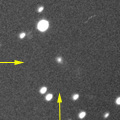
|
Now it is 16.4 mag (June 12, Ken-ichi Kadota). It will reach to 15 mag in 2010. It keeps observable for a long time after this in the Northern Hemisphere.
Date(TT) R.A. (2000) Decl. Delta r Elong. m1 Best Time(A, h)
June 20 15 8.34 6 56.2 5.129 5.827 129 16.7 21:13 ( 0, 62)
June 27 15 6.38 7 19.4 5.178 5.794 122 16.7 21:04 ( 11, 62)
|

|
It will reach up to 14-15 mag from 2011 to 2012. Now it is 17.3 mag (May 1, Ken-ichi Kadota), and locates low in the south.
Date(TT) R.A. (2000) Decl. Delta r Elong. m1 Best Time(A, h)
June 20 15 3.83 -25 13.9 7.672 8.488 141 17.2 21:08 ( 0, 30)
June 27 15 0.86 -25 18.9 7.714 8.453 134 17.2 21:04 ( 7, 29)
|
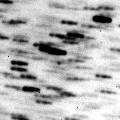
|
Now it is 17.0 mag (June 17, Charles Bell). The condition is good in this apparition. It will approach to the earth down to 0.38 A.U., and will be observable in good condition at 16.5 mag in November. It keeps observable until that time after this. But it locates somewhat low in the Northern Hemisphere.
Date(TT) R.A. (2000) Decl. Delta r Elong. m1 Best Time(A, h)
June 20 16 49.83 -23 22.9 0.795 1.797 165 17.4 22:53 ( 0, 32)
June 27 16 37.84 -22 43.2 0.761 1.738 155 17.4 22:14 ( 0, 32)
|
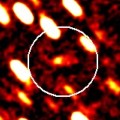
|
Now it is 17.4 mag (June 16, P. Kocher). It will be observable at 17 mag in 2009 summer and 2010 summer.
Date(TT) R.A. (2000) Decl. Delta r Elong. m1 Best Time(A, h)
June 20 17 45.33 -12 48.9 1.866 2.871 169 17.5 23:49 ( 0, 42)
June 27 17 39.78 -12 24.8 1.854 2.848 164 17.4 23:16 ( 0, 43)
|
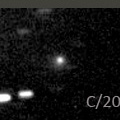
|
It reached up to 15.8 mag in spring (Apr. 20, Catalina Sky Survey). Now it is fading. It has already faded down to 16.8 mag (June 14, Yasukazu Ikari). It will be fainter than 18 mag in July.
Date(TT) R.A. (2000) Decl. Delta r Elong. m1 Best Time(A, h)
June 20 13 17.99 25 46.4 3.132 3.409 97 17.5 21:04 ( 74, 66)
June 27 13 10.97 23 48.2 3.276 3.443 90 17.6 21:04 ( 78, 58)
|
|
![]()
 24P/Schaumasse
24P/Schaumasse 88P/Howell
88P/Howell C/2006 OF2 ( Broughton )
C/2006 OF2 ( Broughton ) C/2007 G1 ( LINEAR )
C/2007 G1 ( LINEAR ) 217P/2009 F3 ( LINEAR )
217P/2009 F3 ( LINEAR ) 29P/Schwassmann-Wachmann 1
29P/Schwassmann-Wachmann 1 65P/Gunn
65P/Gunn C/2006 Q1 ( McNaught )
C/2006 Q1 ( McNaught ) C/2009 E1 ( Itagaki )
C/2009 E1 ( Itagaki ) C/2009 K4 ( Gibbs )
C/2009 K4 ( Gibbs ) 199P/2008 G2 ( Shoemaker 4 )
199P/2008 G2 ( Shoemaker 4 ) (3200) Phaethon
(3200) Phaethon C/2005 L3 ( McNaught )
C/2005 L3 ( McNaught ) C/2008 N1 ( Holmes )
C/2008 N1 ( Holmes ) 77P/Longmore
77P/Longmore C/2008 P1 ( Garradd )
C/2008 P1 ( Garradd ) 144P/Kushida
144P/Kushida C/2008 A1 ( McNaught )
C/2008 A1 ( McNaught ) C/2006 S3 ( LONEOS )
C/2006 S3 ( LONEOS ) C/2008 FK75 ( Lemmon-Siding Spring )
C/2008 FK75 ( Lemmon-Siding Spring ) C/2009 F4 ( McNaught )
C/2009 F4 ( McNaught ) 107P/(4015) Wilson-Harrington
107P/(4015) Wilson-Harrington 219P/2009 H1 ( LINEAR )
219P/2009 H1 ( LINEAR ) C/2008 Q1 ( Maticic )
C/2008 Q1 ( Maticic )![]()
































